
E35 – STALIN vs PIZARRO: The Bracket of Fails – Final Match! (Podcast)
January 18, 2024
Pioneers of the Sky: 25 Epic Aviation Milestones!
February 8, 2024History is full of bold inventors and scientists who pushed the boundaries of what we thought possible and changed the world forever with their brilliant ideas: Leonardo da Vinci, Nikola Tesla, Alexander Graham Bell, The Wright Brothers, etc. But then there are some discoveries and inventions that happened purely by accident! Today we’ll be talking about the latter category…
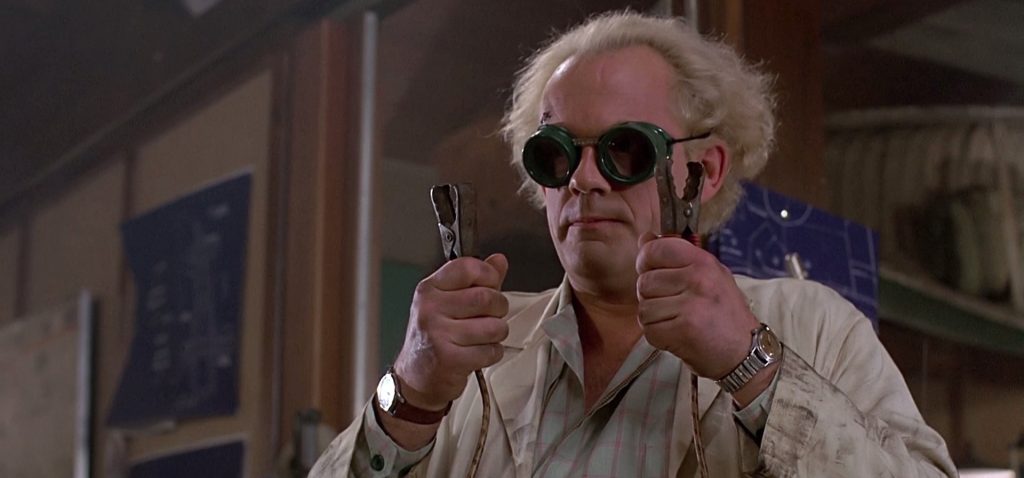
Doc Brown approves this message.
1. The Invention of Gunpowder – 9th Century China?
Considered one of the “Four Great Inventions” of Ancient China – along with the compass, (non-papyrus) paper, and the world’s first printing technique – the ‘explosive’ discovery of gunpowder was a complete and total accident! The earliest recorded description comes from the year 142 AD/CE, in a Taoist document written by Wei Boyang, the “Father of Alchemy”. It is commonly believed that it was discovered (by accident) while Chinese alchemists were attempting to find an elixir of life by mixing certain compounds together.
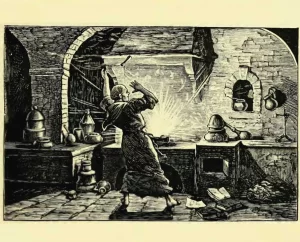
“Whoops!”
Gunpowder was later refined during the late Tang Dynasty (9th Century), and the earliest chemical formula was recorded in the 11th Century, during the Song Dynasty. The Chinese alchemists referred to this black powder as “huo yao” – a blend of charcoal, saltpeter, and sulfur. While it was primarily used for fireworks, there are accounts of early attempts at firearms, using bamboo and iron.

The creation of gunpowder quickly spread across Asia and eventually in to Europe and the Middle East, thanks in large part to a certain Genghis Khan and his Mongol invasions in the 13th Century, who are said to have used fire arrows. During the Mongol Invasion(s) of Japan, gunpowder was probably used for the Mongolian “Thunder-Crash” bombs used against the Samurai defenders. Gunpowder was soon adopted for medieval warfare with the invention of cannons. One of the earliest known examples occurred in Egypt, with the Mamluks at the Battle of Ain Jalut, in 1260. In fact, The Hundred Years War (between England and France) was finally brought to a swift end due to the introduction of artillery weaponry, and the Fall of Constantinople was also decided by the use of firearms.
The first musket was invented by a Spanish armorer in 1499, the first revolver was invented by Samuel Colt in 1835, Hiram Maxim invented the first (non-crank) machine gun in 1884, and during WWII, German inventor Hugo Schmeisser developed the first ‘Assault Rifle’ in 1944. For better or worse (mostly worse), personal handguns have been steadily getting far more efficient and deadly ever since…
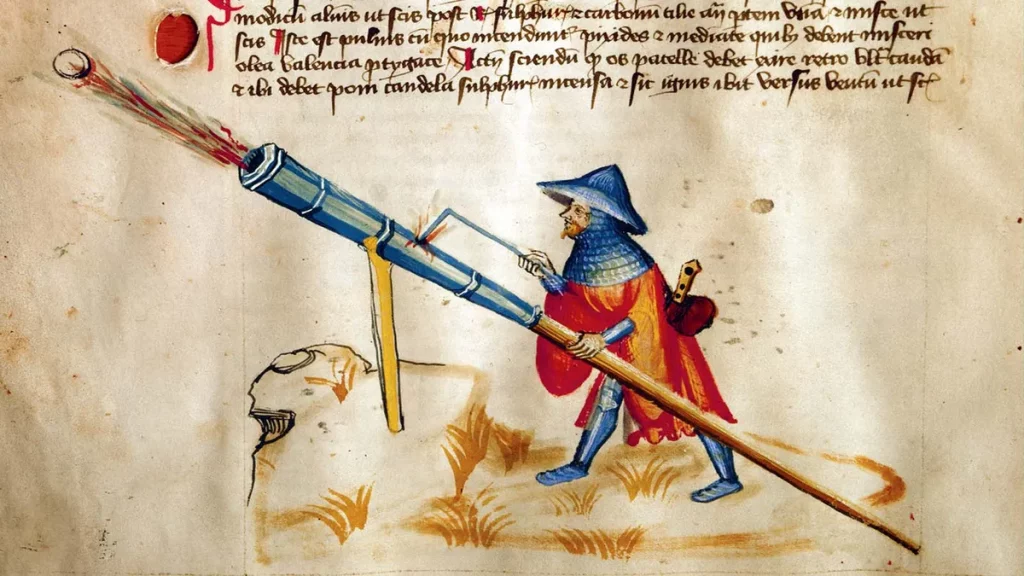
2. The Discovery of Dinosaurs – 1677 / 1842

While some of the earliest dinosaur fossils were attributed as “dragon bones” in Ancient China around 300 BCE, one of the first modern discovery happened in 1677 by Robert Plot in England. Unfortunately, at that point, no one even knew that dinosaurs were even a thing, so he just assumed it was evidence of mythological giants!
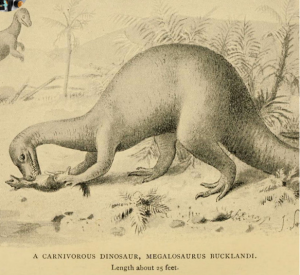
Early (inaccurate) depiction of a Dino
It wasn’t until 1815 that a geologist from Oxford University, William Buckland, realized that the supposed giant bone belonged to a large, carnivorous lizard, when he discovered more fossils from the same species! He later named his discovery the “Megalosaurus” – still long before anyone knew what the heck a dino even was. That didn’t happen until 1842, when Sir Richard Owen categorized these early skeletal finds of different species as “Dinosauria” which means ‘Terrible Lizard’.
Still, these early ‘paleontologists’ didn’t have a great idea of what these large prehistoric creatures even looked like, and some of the early illustrations are often pretty inaccurate and hilarious. Heck, even Steven Spielberg’s masterpiece, “Jurassic Park” (1993), got A LOT of things wrong, mostly because we didn’t yet know that most dinosaurs had feathers… probably.
Because dinosaur fossils are over 65 million years old, and often extremely fragile, they’re pretty rare, so paleontologists are constantly trying to piece together a puzzle without all the pieces to the best of their ability. Although scientists have come along way since then, constantly making massive breakthroughs in the field for the past several decades, there’s still so much we don’t know about these amazing (and terrifying) creatures!

Needs more feathers…
3. The Smallpox Vaccine – 1796
There have been a lot of unfounded claims and senseless conspiracy theories regarding vaccines the last several years, which unfortunately lead to countless (avoidable) deaths during the Coronavirus Pandemic of 2020, but there’s plenty of hard scientific data that shows that vaccines are effective in combating a range of horrible diseases. The best example of the effectiveness of inoculation is the complete eradication of Smallpox, thanks to a vaccine that was first (unknowingly) devised way back in 1796!
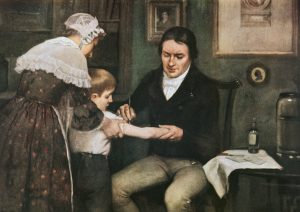
Smallpox was a truly horrific affliction that has plagued the human race for thousands of years and has claimed the lives of hundreds of *millions* of people throughout history. In fact, some of the earliest cases date back to Ancient Egypt, and the disease nearly wiped out the Native American population across two continents, thanks to European colonizers like Spanish Conquistador, Francisco Pizarro. Over the centuries, certain cultures came up with numerous bizarre methods of inoculating against this highly contagious and extremely deadly virus, but no one really knew what viruses were or how they worked. A lot of these early practices seemed like magic at the time. Unfortunately, sometimes these attempts would actually just infect someone with the full disease, leading to their demise.
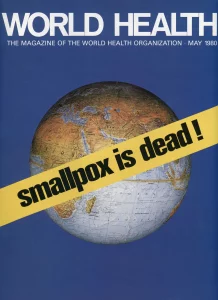
However, it wasn’t until the late 1700’s that an English physician, Edward Jenner, realized that dairy maids who had become infected with “cowpox” (a way less serious version of the disease) weren’t catching Smallpox. He decided to put the theory to the test by using a lancet to transfer contaminated fluid from a Cowpox infection to a young boy, James Phipps. While using an 8-year-old child as a test subject was… questionable to say the least – his hypothesis thankfully proved correct and (after recovering from a mild bout of cowpox) Phipps was now immune to Smallpox!
Although people were suspicious of the procedure at the time (some were even worried about turning into cows?!), it was soon supported by the likes of President Thomas Jefferson and even Napoleon Bonaparte! However, the most amazing part of this whole story is that this initial discovery happened in 1796, a good 60 years or so before Louis Pasteur discovered Germ Theory in the 1860’s!
Since then, tons of other vaccines have saved countless lives. The last person infected by Smallpox was Janet Parker, who died in 1978. On May 8th, 1980, the World Health Organization and the CDC declared that the disease had finally been eradicated for good.

4. Matches – 1826
While early humans first discovered fire in the distant prehistoric past. It may be hard to imagine today, but it was still tricky to come by fire-on-demand for the vast majority of human history. Even after the discovery of gunpowder and the invention of oil lamps, you still needed flint (and the right conditions) to spark a fire. Over the years, inventors tried (and failed) to create an easier way to start a camp fire, like French chemist, Jean Chancel, who nearly blew himself up with a highly unstable chemical concoction in 1805.

It wasn’t until 1826, that an English apothecary named John Walker stumbled onto the answer completely by accident! Walker was working on a completely different project when he made a startling discovery! He casually dragged a wooden stick covered in chemicals against a sheet of paper with phosphorous on it – the friction instantly ignited the small torch – and presumably scared the crap out of him in the process! John Walker immediately began selling these new “Friction Lights”, but never patented the product. It wasn’t until 1855 that the formula was perfected for “Safety Matches”, thanks to the discovery of red phosphorous – much safer and far more stable than the highly toxic white phosphorous compound that was originally used. Not only were the fumes less poisonous, they had way less chance of spontaneously combusting in your pants at random!

Portable Fire: Now with even less hazardous fumes and spontaneous combustion!
5. Vulcanized Rubber – 1839
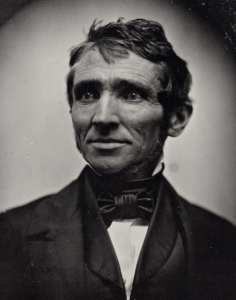
Right as the rubber industry began to take off in 1834, a determined entrepreneur, Charles Goodyear, made it his life’s mission to solve the “sticky” problem of making rubber into a sturdier compound and less of a melty glob of goo. Like any good mad scientist worth his lab coat, Goodyear threw caution to the wind and started mixing random toxic chemicals together just to see what would happen! Despite numerous failures, going completely broke, and even being locked up in a debtor’s prison at one point, he refused to give up!
During one experiment, while heating India rubber and mixing it with Magnesium Oxide, he discovered a chemical compound that appeared to be less sticky and more durable, but when he tried to make shoes out of the material, he found out the hard way that they would start to melt in the sun. Goodyear, who was now on the run from loan sharks with nothing to show for it, was now forced to sell off most of his family’s possessions and even his kids’ text books! However, he decided to keep the fine china… because he realized that they worked great for mixing bowls! (Wow, I’m betting that didn’t earn him any points from the wife.)

Then the obsessed inventor finally had a breakthrough in 1839, by pure coincidence! While heating rubber on a hot stove, he clumsily spilled some Sulphur into the mix! To his astonishment, the compound hardened, even under the intense heat! ‘Vulcanized rubber’ is now one of the most commonly used materials in the modern world, everything from tennis shoes to tires.
Although Charles changed the world with his accidental discovery, he would spend the rest of his life fighting legal battles over his patent, and eventually succumbed to all the years of toxic fumes in the lab. He died on 1860, shortly after learning of his daughter’s own tragic passing.
6. Anesthesia – 1846
Yes that’s right, prior to 1846, pain meds weren’t really a thing. “Got a tooth ache? Better chug this whiskey! Need your leg amputated? Have some more whiskey and then bite down on this dirty rag…” Well, thankfully, that all changed in 1846, thanks to a family dentist from Hartford, Connecticut: Horace Wells – who liked to party like a 19th century Keith Richards. Drugs… he took lots and lots of drugs. Seriously though, this story reads like a prequel to “Fear and Loathing in Las Vegas”.
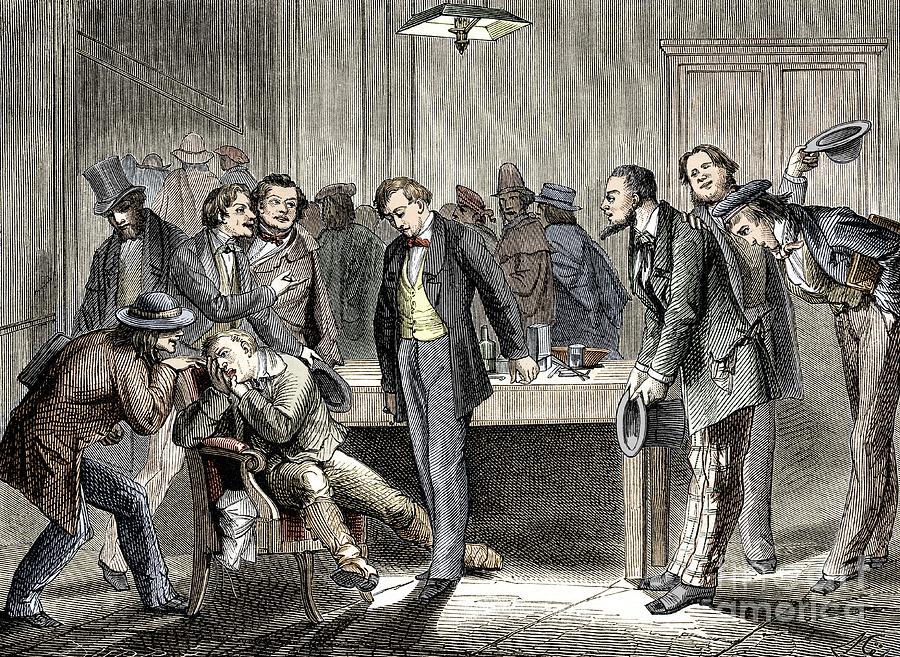
One night, Horace was getting super drunk at a party with his dentist buddies. At some point, they decided to mess around with something called nitrous oxide aka “laughing gas”! They took turns getting super high until one guy stumbled around in a drunken stupor and tripped over himself. Dude busts his leg open and doesn’t even notice! Suddenly, a lightbulb went off in Horace’s head. In that moment, he immediately decided to test it out – on himself, because you know, drugs.

Wells (presumably high as a kite) egged on his assistant to pull one of his teeth out! He continued to experiment with a number of other pain-numbing compounds, including something called “Ether” – which he then showed off to a bunch of doctors in Boston later that year, using the fumes from a flask of Sulphuric Ether to knock his patient “unconscious”. Unfortunately for Horace, his story kinda takes a dark turn when he gets addicted to a little something called chloroform…
Just two years later, in 1848, Wells went on a bender and blacked out. Next thing he knew, he woke up half-naked and disheveled in a jail cell, in New York! As he slowly came to and sobered up, he was mortified to learn that he’d gotten into a fight with not one, but two prostitutes! If all that’s not bad enough, he then finds out that the two women are pressing charges against him – for damages to their clothes. Turns out – he threw acid at them! Luckily, the ladies themselves were ok, but Horace was… not. Tragically, consumed by guilt, he took his own life – after the idiot prison guards let him have a shaving kit. Despite that unfortunate series of events, Horace Wells is still hailed as a hero by anyone who has ever needed to have a root canal.
Oddly enough, even today (in the year 2024) doctors and scientists still don’t fully understand how anesthesia really works, but that’s probably because *consciousness itself* is still very much a mystery to this day. In recent years, some legitimate neuroscientists are now arguing that it may actually originate outside of our physical reality, as we currently understand it – on a quantum plane of existence in fourth dimensional space that challenges all of our preconceived notions of the nature of the universe itself… basically implying that ghosts / spirits / souls might be real, but that’s a much longer and for more metaphysical conversation for a future article. (Read more on all of that in this Scientific American article!)

“You called?”
Listen to Season 6 of Podcasters Assemble for all my thoughts on the “Ghostbusters” franchise!
7. The (Modern) Chewing Gum Industry – Late 1850’s-ish?
Since before recorded history, across numerous cultures all over the world, people have often shoved random stuff in their mouths to see if they could eat it. In fact, this innate habit can be observed in cute babies who tried to nom on their own feets. Even when man discovered he couldn’t really eat said thing, sometimes he would munch on it anyway – even if it tasted really, really bad.
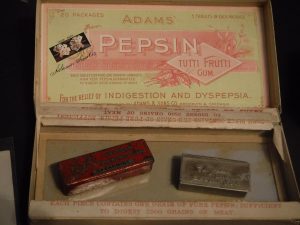
The Native Americans chewed on Spruce-Tree-Resin, the Vikings had Birch-Bark-Tar, and even in Ancient Greece, Pliny the Elder wrote about how all the cool kids were chewing something called ‘mastich’. The Mayans however had their own version – chicle, a rubbery substance found in sapodilla trees, found throughout Mexico and Central America. By cooking and drying it, the Mayans created “cha” – a substance that could clean their teeth and freshen their breath. This eventually made it’s way into Aztec culture as well.
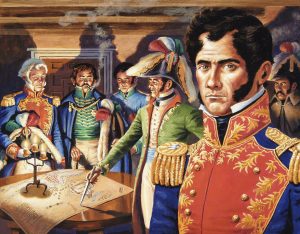
Eventually colonial Americans adopted the indigenous habit of chewing spruce-resin, but it tasted awful, so certain aspiring businessmen, like John B. Curtis, began selling a variation made from sweetened paraffin wax. Then, sometime in the the late 1850’s, the exiled President of Mexico, Antonio López de Santa Anna came to New York – you know, that famous General from “The Battle of the Alamo” (remember the Alamo?). While laying low in the states, Santa Anna’s secretary was a man named Thomas Adams, a part-time photographer / part-time glassmaker.
The Mexican President noticed Adams chewing this gross wax stuff, so he offered him some chicle from back home, and the two hit it off. The former General recognized the man’s inventive spirit, and told him that if someone could figure out a way to turn chicle into a *synthetic* vulcanized rubber (which was expensive and hard to come by), it would change the world. Thomas Adams took up the challenge, so Santa Anna offered him a proposition: he would supply him with a cheap supply of the stuff, and Adams would try and create something useful out of it.

Like Charles Goodyear before him, Thomas Adams spent the next several months hunched over his lab, experimenting with the rubbery substance, desperately attempting to make something out of the gooey tree sap, but no such luck. A year later, he was ready to give up, but didn’t know what to do with this massive supply of useless chicle that he’d wasted all his money on. Then he remembered that they used the stuff as chewing gum back in Mexico and decided to try and sell it that way, and eventually in 1869 decided to try adding some flavor to it. By 1871, he was mass producing his own brand of gumballs, which were soon selling out at drug stores across New York City for a penny a piece! In 1888, it became the first chewing gum sold in vending machines!
After taking out the competition in 1899, Adams basically had a monopoly over the now booming Chewing Gum industry in North America, and after a merger, was now the first chairman of “The American Chicle Company”. However, shortly after Thomas’s death in 1905, William Wrigley Jr. of Chicago dethroned the heir to the ‘Bubble Gum Kingdom’ with a cut-throat marketing strategy, a relentless advertising campaign, and his two secret weapons: “Spearmint” and “Juicy Fruit”!

“Look on my works, ye Mighty, and despair!”
8. DYNAMITE! – 1867
Swedish chemist-turned-inventor, Sir Alfred Nobel, was a complicated man of many contradictions: a romantic who was a loner at heart, an idealist who distrusted democracy, and a pacifist who made weapons of war…

Born in 1833, Alfred’s family moved to St. Petersburg, Russia in 1842, where his father manufactured munitions. After studying chemistry in Paris and traveling abroad to the United States, Nobel returned to Russia in 1852, just in time to help in the family business of making explosives for The Crimean War (aka ‘World War Zero’).
After the war ended, his father’s company immediately went bankrupt, but Alfred decided to stay behind at his father’s estate where the young genius decided to play around with explosives, as you do. Throughout the 1860’s, Nobel began pursuing a better alternative to the run of the mill ‘black powder’, and decided to experiment with a little something called Nitroglycerin – which had been discovered (accidentally) by Ascanio Sobrero when the compound blew up in his face in 1847, seriously injuring him.

“Uh oh…” -Ascanio Sobrero, 1847
Although nitroglycerin was far more powerful than other bombs at the time, it was highly unstable, and Sobrero even warned others to avoid using it at all costs. Undeterred, in 1862, Nobel set up shop, building a nitroglycerin factory in Stockholm, Sweden, where he invented the detonator and blasting cap. Unfortunately, just 2 years later, the nitroglycerin factory exploded, killing 5 people, including Alfred’s younger brother, Emil, in 1864. After relocating his lab to a more remote area, undaunted by the recent tragedy, Alfred Nobel started up a new company in Hamburg, Germany, in 1865, where he continued to try and find a way to make a safer explosive.
By pure chance, in 1867, Nobel discovered that a certain type of dirt, kieselguhr, absorbed the liquid, making it far more stable, making the compound both easier and safer to transport and use. He originally wanted to call it “Nobel’s Blasting Powder”, but at some point someone convinced him to change it to “DYNAMITE”! – derived from the Greek word: “Dynamis”, meaning power.

Sir Alfred Nobel, the first man to walk away from an explosion in slow motion.
The invention of Dynamite changed the world overnight, allowing quicker construction of railways, roads, tunnels, and canals – not to mention the potential for weapons. It also just so happened to make Alfred Nobel immensely wealthy. The creator of dynamite continued to innovate, creating an early form of blasting gelatin in 1875, and in 1887, he created ballistite, a precursor to cordite, and in 1893, he became an arms dealer. Outside of building fancy bombs, Nobel also created artificial silk and leather, registering over 350 patents in his name.
Meanwhile, Ascanio Sobrero was horrified to hear that his discovery was being perpetuated by the machinations of industry, “When I think of all the victims killed during nitroglycerin explosions, and the terrible havoc that has been wreaked, which in all probability will continue to occur in the future, I am almost ashamed to admit to be its discoverer.” Alfred Nobel on the other hand, always hoped that by making more efficient killing machines, it would make the thought of war unthinkable.
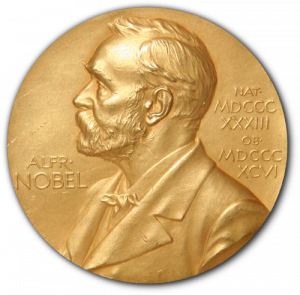
However, in 1888, something happened that caused Nobel to reconsider his legacy. When his brother Ludvig passed away, a French newspaper accidentally published an obituary for Alfred, which labeled him as “The Merchant of Death”. The paper stated “Dr. Alfred Nobel, who became rich by finding ways to kill more people faster than ever before, died yesterday.” After reading his own obituary, Nobel was shook, and realized he didn’t want to be remembered for creating weapons of war. In his later years, Alfred decided to donate his incredible wealth to creating the Nobel Prize foundation, which continues to recognize individuals for their contributions to humanity, to this day.
So yeah, the creator of the Nobel Peace Prize also just so happens to be the same guy who gave us dynamite – which further contributed to the industrialization of war…

He was also the inspiration for Tony Stark.
9. Coca-Cola – 1886
One of the most famous brands in the world today also had an unusual and somewhat disturbing backstory, because sometimes the American dream is actually a nightmare…

An American pharmacist from Georgia, Dr. John Pemberton, became a Confederate soldier during the Civil War. Yup, that’s right, he was on the side fighting for “states rights” – as in “the states rights to own slaves” – aka the wrong side.
On April 16th, 1865, the final battle of this long, bloody conflict broke out, on the border of Alabama and Georgia. Unfortunately, for everyone involved, this was actually one week *after* Robert E. Lee officially surrendered to Lt. General (and future President) Ulysses S. Grant at Appomattox Court House on April 9th – effectively ending the war, and just 2 days after President Abraham Lincoln was tragically shot by John Wilkes Boothe on Friday, April 14th, 1865. Turns out, the Union commander, Major General James H. Wilson, never got the memo.
At the Battle of Columbus, the remaining Confederate soldiers lost – badly. During this vicious confrontation, Colonel John Pemberton was stabbed in the chest with a saber. As fate would have it though, Pemberton survived his grave injury, but he was left in near-constant pain, so had to take morphine on a regular basis, just to cope with day-to-day life. As a result, he soon became addicted to the drug, and decided to make it his life mission to try and find a non-Opioid pain-killer. He set out to make medicine and instead came up with a sugary soft drink that would eventually be the leading cause of a global diabetes epidemic.

Dr. Pemberton’s original recipe was called “Dr. Tuggle’s Compound Syrup of Globe Flower” – which literally included a toxic ingredient derived from the Alaskan buttonbush plant! By the mid 1880’s the mad scientist had came up with another random concoction he labeled as “Pemberton’s French Wine Coca” – a mixture of (no joke) cocaine, alcohol, and highly-caffeinated ‘kola nuts’. So basically a drug-fueled cocktail that would be extremely illegal (and dangerous) if it were sold today. Worth noting: the FDA wasn’t a thing until 1906.
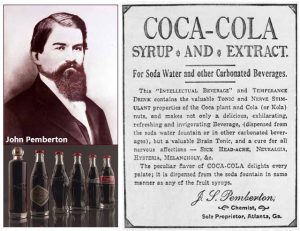
Pemberton’s “French Wine” became an instant hit, which is no real surprise considering all three of it’s main ingredients are highly addictive substances, but then in 1886, the early Temperance Movement began to gain momentum in the south (which would later lead to Prohibition in the 1920’s). Being the enterprising businessman he was, this ex-Confederate veteran decided to make a non-acholic version of his caffeinated cocaine water.
While in the lab, tinkering with the alcohol-free version of his coke-laced beverage, he decided to use syrup instead of wine. During the process, he accidentally spilled carbonated water into the mix – and the fountain drink industry was born! Eventually marketed as “Coca-Cola”, the company decided to remove cocaine from the product in 1899, shortly after Asa Griggs Candler purchased the formula from Pemberton in 1888 for just $238.98! It goes without saying that the Coca-Cola brand has gone on to become a global juggernaut, with more power, money, and influence than most countries. Unfortunately for Pemberton himself, his morphine addiction eventually caught up with him, and he died in poverty that same year…

10. X-Rays – 1895
“X-Rays” were first discovered (by accident) by a German physicist, Wilhelm Röntgen, who was experimenting with cathode ray tubes. This was before we really understood electricity (It was still rather new concept to most people, with Westinghouse and Tesla’s ‘Alternating Current’ just now coming into vogue, replacing Edison’s ‘Direct Current’), and a couple years before the discovery of radiation. In 1895, Wilhelm was investigating the external effects of an electrical discharge through various types of vacuum tubes at his lab. During one such experiment, he suddenly noticed a weird glow coming from a nearby chemically coated screen!

Röntgen decided to investigate this phenomenon further, attempting to shield the tubes with different materials to see what would block it, and eventually discovering that these “unknown rays”, which he dubbed ‘X-Rays’, would could even imprint on photographic film! He also figured out that these invisible rays could penetrate the human body, but were blocked by bones and other dense materials. At the time, people had no idea that there was a spectrum of light beyond what our eyes can visually see, but he proved his findings by taking an x-ray image of his wife’s hand!
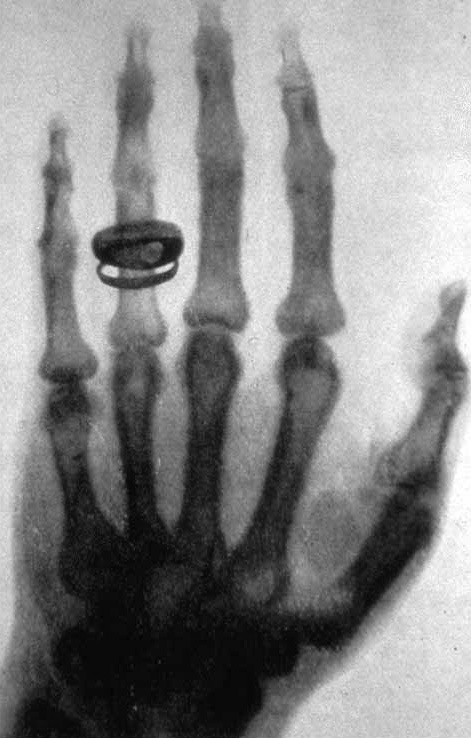
Like vaccines and anesthesia, this discovery was a profound medical breakthrough, allowing doctors to see inside the human body without invasive surgery. By 1897, X-Rays were being used on the battlefield during the Balkan War, but it wasn’t until 1904 that people realized the harmful effects of X-Ray radiation, when Thomas Edison’s assistant, Clarence Dally, died of skin cancer from overexposure to the powerful invisible rays! Wilhelm Röntgen was awarded the Nobel Peace Prize for his groundbreaking discovery, in 1901.
– Erik Slader
For more random history stuff, be sure to check out the Epik Fails of History podcast, and you can find my “Epic Fails” history books on Amazon and Audible!

Sources:
https://en.wikipedia.org/wiki/History_of_gunpowder
https://science.howstuffworks.com/innovation/inventions/who-invented-the-first-gun.htm
https://www.discovery.com/science/First-Dinosaur-Fossil-Name
https://www.mentalfloss.com/article/55146/10-odd-early-interpretations-dinosaurs
https://askabiologist.asu.edu/vaccine-discovery
https://www.who.int/news-room/spotlight/history-of-vaccination/history-of-smallpox-vaccination
https://blog.byjus.com/knowledge-vine/origin-story-vulcanised-rubber/
https://theconversation.com/a-short-history-of-anaesthesia-from-unspeakable-agony-to-unlocking-consciousness-74748
https://www.smithsonianmag.com/arts-culture/a-brief-history-of-chewing-gum-61020195/
https://www.discovermagazine.com/technology/5-inventions-that-were-discovered-by-accident
https://www.history.com/news/accidental-inventions#coca-cola
https://www.britannica.com/biography/Alfred-Nobel
https://www.smithsonianmag.com/smart-news/man-who-invented-nitroglycerin-was-horrified-dynamite-180965192/
https://www.history.com/this-day-in-history/german-scientist-discovers-x-rays
https://www.britannica.com/science/X-ray




